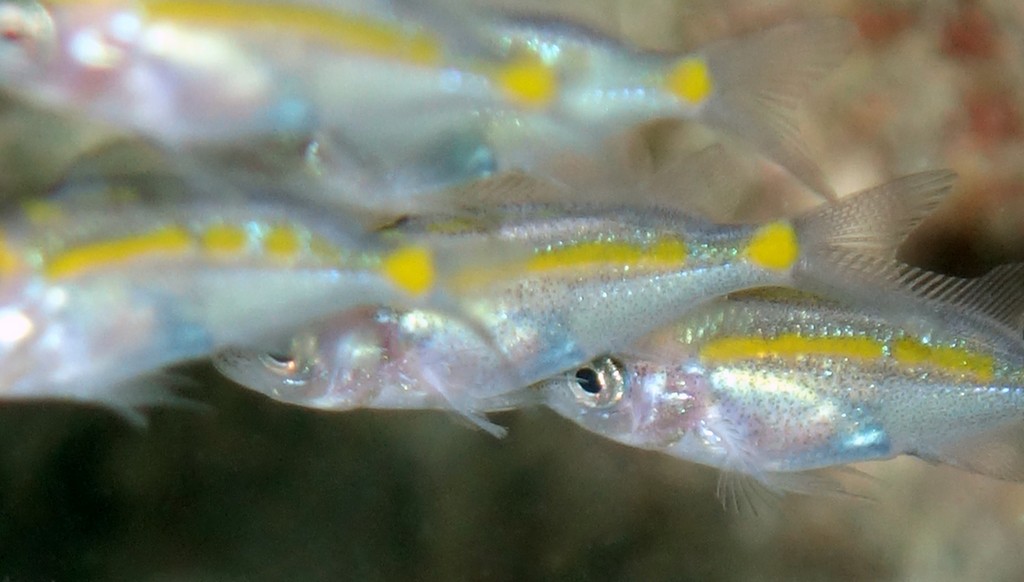ACANTHOCHROMIS POLYACANTHUS - (BLEEKER, 1855)
Picture courtesy of: Alain Daoulas
Actinopterygii (Gigaclass) > Actinopteri (Class) > Teleostei (Subclass) > Blenniiformes (Order) > Pomacentridae (Family) > Pomacentrinae (Subfamily) > Acanthochromis (Genus)
Chromis à épines, Spiny puller, Spiny chromis, Spotty-tail, Spiny-tail puller, 多刺棘光鰓鯛,
Synonymes
Abudefduf jordani (Seale, 1906)
Acanthochromis polyacathus (Bleeker, 1855)
Acanthochromis polycanthus (Bleeker, 1855)
Acanthocromis polyacanthus (Bleeker, 1855)
Chromis desmostigma (Fowler & Bean, 1928)
Dascyllus polyacanthus (Bleeker, 1855)
Heptadecanthus brevipinnis (De Vis, 1885)
Heptadecanthus longicaudis (Alleyne & MacLeay, 1877)
Heptadecanthus maculosus (De Vis, 1885)
--------------------------------
Description
Dorsal spines (total): 17; Dorsal soft rays (total): 14-16; Anal spines: 2; Anal soft rays: 14-16; Pectoral fin rays: 17-18; Lateral line scales: 20-22; Gill rakers: 21-23; Body depth: 1.7-2.0 in SL. Max. length : 14.0 cm TL. Depth range: 1 - 65 m, usually: 4 - 20 m.
Color
This damselfish has a number of color variants, and ranges from whitish to all brown or dark grey, sometimes with a white tail.
Etymology
Acanthochromis: from ancient Greek, ákanthos = thorn, spine + Chromis: from Greek, chroemo = to neigh. A name dating to Aristotle, referring to a drum (Sciaenidae) and its ability to make noise; Later applied to this damselfish and subsequently expanded to embrace dottybacks, cichlids and wrasses (all perch-like fishes once thought to be related). Referring to 17 dorsal-fin spines; Chromis, presumably similar to and/or related to that genus.
polyacanthus: from Ancient Greek, polús = many, much + from ancient Greek, ákanthos = thorn, spine. Referring to 17 dorsal-fin spines.
Original description: Dascyllus polyacanthus Bleeker, 1855 - Type locality: Batjan, Molucca Islands, Indonesia.
Distribution
Western Pacific: Eastern Indonesia east to Philippines, New Ireland (Papua New Guinea), Solomon Islands and Vanuatu, south to northern Australia and New Caledonia.
Distribution
Western Pacific: Eastern Indonesia east to Philippines, New Ireland (Papua New Guinea), Solomon Islands and Vanuatu, south to northern Australia and New Caledonia.
Biology
Adults inhabit inshore and offshore coral reefs. Also found in harbors, lagoons. School as they grow and sub-adults are usually seen in small groups. Adults form pairs and are territorial when breeding. Feeds on plankton and algae in the water column, and also steals algae from the farms of Pomacentrus and Stegastes. Younger individuals have been known to eat mucus off the adults. Oviparous, distinct pairing during breeding. Monogamous mating is observed as both obligate and genetic. Females lay large demersal eggs which adhere to the substrate, and the larvae hatch after 15-17 days (other damselfishes hatch after about 5 days). The larvae are well-developed at hatching and swim and remain in a tight school near the nest site. For several weeks, they are guarded by the parents, and the juveniles gradually disperse to nearby areas on the reef. Does not have a juvenile bisexual phase and all males have the typical testicular morphology of gonochores.
Acanthochromis polyacanthus are unusual as they brood their young, whereas most coral reef fishes have a pelagic larval stage. This behavior is clearly visible on the reef, by the presence of pairs of adult fish aggressively defending a cloud of fry that remain around the parents. Acanthochromis share this behavior with the close genus Altrichthys.
Similar species
- Altrichthys azurelineatus (Fowler & Bean, 1928) - Reported from Western Pacific: Philippines endemic.
- Azurina elerae (Fowler & Bean, 1928) - Reported from New Caledonia - Link to the species (here).
- Azurina lepidolepis (Bleeker, 1877) - Reported from New Caledonia - Link to the species (here).
- Chromis flavaxilla (Randall, 1994) - Reported from Red Sea; Northwestern Indian Ocean: Gulf of Aden, Socotra, Gulf of Oman, Persian Gulf.
- Chromis ternatensis (Bleeker, 1856) - Reported from New Caledonia - Link to the species (here).
- Pycnochromis amboinensis (Bleeker, 1871) - Reported from New Caledonia - Link to the species (here).
- Pycnochromis atripes (Fowler & Bean, 1928) - Reported from New Caledonia - Link to the species (here).
- Pycnochromis iomelas (Jordan & Seale, 1906) - Reported from New Caledonia - Link to the species (here).
Last update: 24, September 2021
